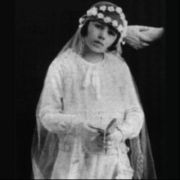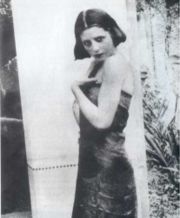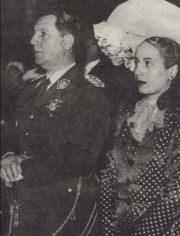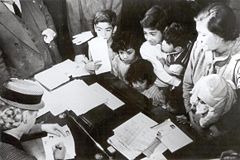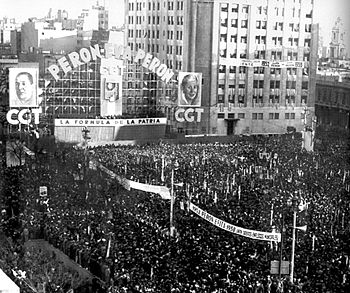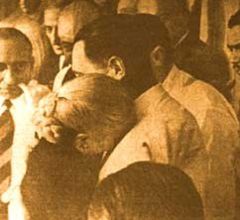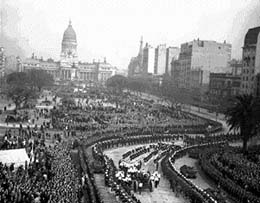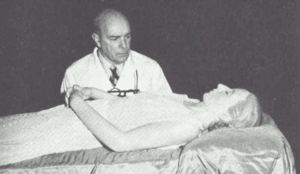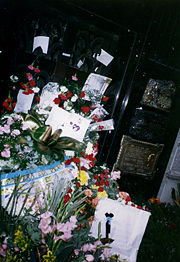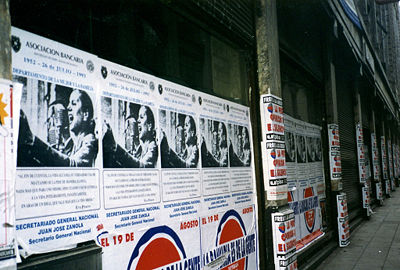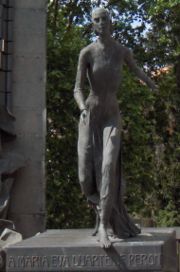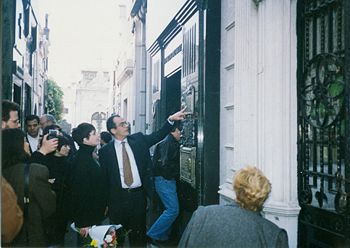Eva Perón
2008/9 Schools Wikipedia Selection. Related subjects: Political People
|
María Eva Duarte de Perón
|
|
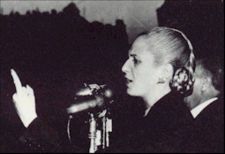 |
|
|
Spiritual Leader of the Nation of Argentina
|
|
| In office May 7, 1952 – July 26, 1952 |
|
| Preceded by | None; Position created |
|---|---|
| Succeeded by | None; Post abolished following death of Eva Duarte de Perón |
|
Nominee of the Peronist Party for offices of Vice President of Argentina and Argentine Senate President |
|
| In office 22 August – 17 October 1951 |
|
| Preceded by | Juan Hortensio Quijano |
| Succeeded by | Juan Hortensio Quijano |
|
Head of the Ministry of Labour and Social Welfare of Argentina
Serving with Secretary Jose Maria Freire |
|
| In office June 4, 1946 – July 26, 1952 |
|
| President | Juan Perón |
| Preceded by | Juan Perón |
| Succeeded by | Jose Maria Freire |
|
Head of the Ministry of Health of Argentina
|
|
| In office June 4, 1946 – July 26, 1952 |
|
| President | Juan Perón |
|
President of the Female Peronist Party
|
|
| In office 1947 – 1952 |
|
| Preceded by | None |
| Succeeded by | Delia Parodi |
|
President of the Maria Eva Duarte de Perón Foundation
|
|
| In office 1948 – 1952 |
|
| President | Juan Perón |
| Preceded by | None |
| Succeeded by | Juan Perón |
|
First Lady of Argentina
|
|
| In office June 4, 1946 – July 26, 1952 |
|
| President | Juan Perón |
| Preceded by | Conrada Victoria Torni |
| Succeeded by | Vacant |
|
|
|
| Born | May 7, 1919 Los Toldos, Argentina |
| Died | July 26, 1952 (aged 33) Buenos Aires, Argentina |
| Nationality | Argentinian |
| Political party | Justicialist Party Peronist Feminist Party |
| Spouse | Juan Perón (1895–1974) |
| Occupation | Actress Philanthropist First Lady Politician |
María Eva Duarte de Perón ( May 7, 1919 – July 26, 1952) was the second wife of President Juan Domingo Perón (1895–1974) and served as the First Lady of Argentina from 1946 until her death in 1952. She is often referred to as simply Eva Perón, or by the affectionate Spanish language diminutive Evita, which literally translates into English as "Little Eva".
She was born out of wedlock in rural Argentina in 1919. At the age 15, Eva Duarte made her way to the nation's capital of Buenos Aires where she pursued a career as a stage, radio, and film actress. Eva met Colonel Juan Perón in 1944 at a charity event in San Juan. The two were married the following year. In 1946, Juan Perón was elected President of Argentina. Over the course of the next six years, Eva Perón became powerful within the Pro-Peronist trade unions, essentially for speaking on behalf of labor rights. She also ran the Ministries of Labor and Health, founded and ran the charitable Eva Perón Foundation, and founded and ran the nation's first large-scale female political party, the Female Peronist Party.
In 1951, Eva Perón accepted the Peronist nomination for the office of Vice President of Argentina. In this bid she received great support from the Peronist political base, low-income and working class Argentines referred to as descamisados or "shirtless ones". However, opposition from the nation's military and elite, coupled with her declining health, ultimately forced her to back down. In 1952, shortly before her death, Eva Perón was given the official title of "Spiritual Leader of the Nation" by the Argentine Congress.
Early life
Early childhood
Born on May 7, 1922 as the birth certificate for María Eva Duarte in Junín's civil registry says, but on May 7, 1919 as Eva María Ibarguren, as her Baptism certificate says. Her Junín birth certificate appears to be a forgery made by her when she was in town for her marriage. Eva Perón's autobiography, La Razón de mi Vida, contains no dates or references to childhood occurrences, and does not list the location of her birth or her name at birth.
Perón spent her childhood in Junín, Buenos Aires Province, then a village in the Pampas. Her parents, Juan Duarte and Juana Ibarguren (often referred to as Doña Juana), never married. Duarte was a rancher from nearby Chivilcoy, where he already had a wife and family. It should be noted that in rural Argentina, during that time, it was not uncommon to see a high-class male with multiple families.
In 1920, when Eva was a year old, Duarte returned to his legal family, leaving Juana Ibarguren and her family of five children impoverished. As a result of the impoverishment, Ibarguren and her family moved to the poorest area of Junín. As a means of supporting herself and her children, Ibarguren sewed clothes for neighbors. The family was stigmatized by the abandonment of the father, especially since the Argentine law frowned upon illegitimate children. Eva allegedly had her birth certificate destroyed in 1945 so as to erase this part of her past.
Junín
Juan Duarte had been Juana Ibarguren’s sole means of support. All that he left to the family was a document declaring that the children were his (so they could bear his last name). In order to pay the rent on their one-room home, mother and daughters took up jobs as cooks in the houses of the local estancias. In La Razón de mi Vida (The Reason for my Life), Eva wrote:
“I remember I was very sad for many days when I discovered that in the world there were poor people and rich people; and the strange thing is that the existence of the poor did not cause me as much pain as the knowledge that at the same time there were people who were rich…From each year I kept the memory of some injustice that roused me to rebellion.”
Eventually, thanks to the older brother's financial help, the family moved into a bigger house which would become their main income as it was transformed into a boarding house and a restaurant. During this time, young Eva would participate enthusiastically in all of her school plays and concerts, the main distractions for her and her siblings were the cinema and watching trains come into the station from Buenos Aires. Her mother’s plans for Eva extended no further than marrying her off to one of the bachelors who lodged at the house, and joining her in running it. Eva determined a different path after October 1933 when she played a small role in a school play called Arriba Estudiantes (Students Arise), “an emotional, patriotic, flag-waving melodrama.” After the play she was determined to become a great actress.
Move to Buenos Aires
According to several historians, in 1934 Eva suffered an attempted rape. Eva and a girlfriend had been invited on a trip to the coastal city of Mar del Plata by some male friends. However, as soon as the party left Junín the men attempted to force the girls into sex. When they resisted, they were abandoned in the middle of the road. That same year, fifteen year old Eva decided to quit school and try her luck in Buenos Aires, but she had to go back to Junín after she couldn't find a job. She then finished primary school in Junín, and spent New Year's Eve 1935 with her family, but on January 2, 1935 she moved definitely to Buenos Aires. In her autobiography she explains that all the people from her town that had been to the big cities described them as "marvelous places, where nothing was given but wealth", so she figured out that Buenos Aires was the place for her to get away from the misery that surrounded her in the country.
Certain biographers and most of Eva Peron depictions in popular culture, imply that she traveled to Buenos Aires by train with tango singer Agustín Magaldi. However, Evita's biographers Marysa Navarro and Nicholas Fraser sustain that this didn't happen based on the fact that Magaldi didn't perform in Junín during 1934, and also based on Eva's sister's allegations that her mother stayed in Buenos Aires until Eva had a job. Doña Juana took her daughter to audition at a radio station, and Eva arranged to stay on at the home of family friends, the Bustamontes."
"Buenos Aires in the 1930s was the continent's most cosmopolitan and elegant metropolis and soon became known as the 'Paris of South America.' As in any great European capital, the centre of the city was filled with cafés, restaurants, theaters, movie houses, shops, and bustling crowds. Eva was one of many people from the provinces, attracted by the process of industrialization, who came to the capital during the 1930s. When she arrived with little more than a cardboard suitcase containing her few possessions, the bold teenager must have felt a wrenching sense of vulnerability and solitude. In direct contrast to the glamour of the city, the 1930s were also years of great unemployment, poverty, and hunger in the capital, and many immigrants from the interior were forced to live in tenements, squalid boardinghouses, and in outlying shantytowns that became known as villas miserias."
Upon arrival in Buenos Aires, Eva Duarte was faced with the difficulties of surviving without formal education and without connections. The city was specially overcrowded during this period because of the migratory waves caused by the great depression. On March 28, 1935 she had her professional debut in the play "The Perezes Misses", at the Comedias Theatre. The next day the newspaper Crítica made the first known public comment about Eva:
"...very correct during her short interventions Eva Duarte..."
The next year she toured nationally with a theatre company, worked as a model and got a few roles in B-grade movie melodramas. In August 1937, she worked for the first time in a radio drama called White Gold, which talked about the everyday life of Chaco's cotton workers. In 1942 she had a breakthrough towards economic stability when a company called Candilejas (sponsored by a soap manufacturer) hired her for a daily role in of their radio dramas, which aired on Radio El Mundo, the most important radio station in the country at that time. Later that year she signed a five-year contract with Radio Belgrano, which would assure her a role in a popular historical-drama program called Great Women of History where she played Elizabeth I of England, Sarah Bernhardt and the last Tsarina of Russia. Eventually, Eva Duarte came to co-own the radio company. By 1943, Eva Duarte was earning five or six thousands pesos a month, making her one of the highest paid radio actresses in the nation during this time period. Pablo Raccioppi, who jointly ran Radio El Mundo with Eva Duarte, is said to have not liked her but to have noted that she was "thoroughly dependable". Eva also had a short lived film career, but none of the films in which she appeared were hugely successful. In one of her last films, La Cabalgata del Circo (The Circus Cavalcade), Eva played a young country girl the rival of an older woman, the movie's big star, Libertad Lamarque.
Between the radio dramas and the films, Eva achieved a stable and comfortable economical situation, and in 1942 she was able to move out of her pension and into her very own apartment in the exclusive neighbourhood of Recoleta (Posadas street 1567), the very same place that she would, three years later, inhabit with Perón. The next year Eva would also begin her career in politics, as she was one of the founders of the Argentinian Radio Syndicate (ARA).
Early relationship with Juan Perón
Juan Perón was born on October 8, 1895, in Lobos, Argentina. He spent his childhood in the desert of Patagonia at the southern tip of Argentina. He entered the Argentine military academy at age sixteen and joined the Argentine army in 1915. After graduation, Perón was posted to various garrisons in the country's interior. In 1926, Perón was promoted to captain and moved to Buenos Aires. He played a minor role in the 1930 coup. Fraser and Navarro claim that the 1930 coup established a new relationship between the army and the government. Within the military there was some debate as to whether military intervention in politics was appropriate, and whether it should impose the corporate state on Argentina.
Perón was appointed military attache to Chile in 1936. Three years later, shortly before the outbreak of World War II, Perón was sent to Europe, where he would travel through Hungary, Austria, Germany, Spain, and Portugal. Fraser and Navarro claim that during this era Perón was exposed to the theatrics of Benito Mussolini's pseudo-imperial Rome. Perón returned to Argentina in 1942. Fraser and Navarro also claim that Perón, along with much of Europe during this period, believed that the only real choice for Europe was the choice between communism and fascism.
On January 15, 1944, an earthquake occurred in the town of San Juan, Argentina. Six thousand people were killed. In response, Perón, who was then the Secretary of Labour, established a fund to raise money to aid the victims. He devised a plan to have an "artistic festival" as a fundraiser, and invited radio and film actors to participate. As part of the festivities, the actors walked through the streets of San Juan with collection boxes.
After a week of fundraising, all participants met at a gala. It was at this gala, on January 22, 1944, that Eva Duarte first met Juan Perón. Evita referred to the day she met her future husband as her "marvellous day". In his own memoir, Juan Perón recalls his first impression of his future wife:
"There was a woman of fragile appearance, but with a strong voice, with long blonde hair falling loose to her back and fevered eyes. She said her name was Eva Duarte, that she acted on the radio and that she wanted to help the people of San Juan. I looked at her and felt overcome by her words; I was quite subdued by the force of her voice and her look. Eva was pale but when she spoke her face seemed to catch fire. Her hands were reddened with tension, her fingers knit tightly together, she was a mass of nerves."
Fraser and Navarro, however, claim that Juan Perón's memoirs are not always trustworthy. For example, Eva Duarte was not yet a blonde when she met Perón. Fraser and Navarro write that whenever Juan Perón spoke of his political life he was always concerned with placing himself in the best possible light, and this was certainly the case with Evita, who would become his most important political follower. Fraser and Navarro write that Juan Perón and Evita left the gala together at around two in the morning.
"His relations with women abound in enigma. He found much happiness with his first wife, a very private homebody. Was he the same husband whose second wife, an actress, wrought changes in the entire political and social order? Was either of these husbands the one who made his third wife, a nonpolitical dancer of minor public skills, the vice-president of Argentina and, as his successor, the first female president in the Western Hemisphere? One Perón valued women more for their company than for their bodies, and another at the age of fifty-eight took a fourteen-year-old mistress, perhaps in subconscious search of the child he never fathered. One part of him was traditional male and another part defied the mores of a male-dominated society."
Shortly after meeting in San Juan, Eva Duarte and Juan Perón moved in together. This move is said to have scandalized some in Juan Perón's inner circle. During this time period in Argentina actors and politicians were seen as two distinct classes of people. Additionally, it was considered improper for an unmarried couple to live together. But Juan Perón introduced her to his inner circle of political associates and advisors. Juan Perón even allowed Eva Duarte to sit in on his meetings with close advisors and members of government.
"She would stay through the meeting, making the coffee, emptying the ashtrays or watching the guests in silence. Her presence among these educated men — graduates of the War College, doctors from the university or lawyer politicians — would not have been entirely accepted if she had been married to Perón; as it was, it was quite incomprehensible. Evita had little education, and the sort of work she did on the radio was not considered respectable ... But to allow her to be part of his life in this way was damaging for him as a soldier and as a politician. As a soldier his prospects for promotion would be curtailed; as a politician he would be involved in scandal."
Fraser and Navarro claim that Eva Duarte had no knowledge or interest in politics prior to her meeting of Juan Perón. Therefore, she never argued with Perón or any of his inner circle but merely absorbed what she heard. Juan Perón would later claim in his memoir that he purposefully selected Eva Duarte as his pupil and set out to create in her a "second I". Fraser and Navarro, however, suggest that Juan Perón allowed Eva Duarte such intimate exposure and knowledge of his inner circle because of his age. Juan Perón was 48 when he met the 24-year-old Eva Duarte. He had come to politics late in life and was therefore free of preconceived ideas of how his political career should be conducted.
In May 1944 it was announced that broadcast performers must organize themselves into a union, and that this union would be the only one permitted to operate in Argentina. Shortly after the union was formed, Eva Duarte was elected its president. Fraser and Navarro speculate that Juan Perón made the suggestion that performers create a union, and the other performers likely felt it was good politics to elect his mistress. Shortly after her election as president of the union, Eva Duarte began a daily program called "Toward a Better Future" which dramatized in soap opera form the accomplishments of Juan Perón. Often, Perón's own speeches would be played during the course of the program. When she spoke, Eva Duarte spoke in ordinary language as a regular woman who wanted listeners to believe what she believed about Juan Perón.
Rise to power
Perón's arrest
| History of Argentina |
|---|
 |
| Pre-Columbian |
| Indigenous peoples |
| Spanish rule |
| Viceroyalty of the Río de la Plata British invasions |
| An independent nation |
| May Revolution War of Independence Congress of Tucumán |
| Building a nation |
| 1853 Constitution Conquest of the Desert Generation of '80 Immigration The Radicals in Power (1916-1930) The Infamous Decade |
| Age of the Peróns |
| Juan Perón Eva Perón Eva Perón Foundation Partido Feminista Evita Perón's European Rainbow Tour General Confederation of Labour
|
| Argentina from 1955 to 1976 |
| Revolución Libertadora Revolución Argentina |
| Military government |
| Dirty War Falklands War (Guerra de las Malvinas) |
| Democracy and crisis |
| Mothers of the Plaza de Mayo Trial of the Juntas Carapintadas The Argentinazo |
| Present-day Argentina |
| History by topic |
| Military Nationality |
| Timeline |
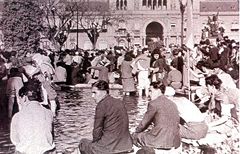
By early 1945, a group of Army officers called the GOU for "Gobierno, Orden, Unidad" (Government, Order, Unity), nicknamed "The Colonels," had gained considerable influence within the Argentine government. President Pedro Pablo Ramírez became wary of Juan Perón's growing power within the government but was unable to curb that power. On February 24, 1944, Ramírez signed his own resignation paper which Fraser and Navarro claim was drafted by Juan Perón himself. Edelmiro Julián Farrell, a friend of Juan Perón's, became President. Juan Perón returned to his job as Labor Minister. Fraser and Navarro claim that by this point Perón was the most powerful man in the Argentine government. On October 9, 1945, Juan Perón was arrested by his opponents within the government who feared that due to the strong support of the descamisados, the workers and the poor of the nation, Perón's popularity might eclipse that of the sitting president.
Six days later, between 250,000 and 350,000 people gathered in front of the Casa Rosada, Argentina's government house, to demand Juan Perón's release. Their wish was granted. At 11 pm Perón stepped on to the balcony of the Casa Rosada and addressed the crowd.
"The reasons for the enormous success of October 17, both at the time and subsequently in the Argentine collective memory and imagination, are easy to discern. The events that began on October 9, with Perón's temporary fall were inherently dramatic, irresistibly so to a nation in which politics are so preeminent. But an important facet in the legendary of October 17 must surely be the accord between those events and the Argentine civilization. So many of the Creole values and sentiments were embedded in the scenario of October. There was the caudillo theme, for Perón no less than Rosas and Yrigoyen was in the caudillo tradition of the leader who embodies the popular aspirations and leads his people by force or strength and by psychological identification with them. There was all the personalism of Hispanic inheritance, for the tale of that night was of a complete and exclusive personal affinity. The mystic overtones were a reminder of the quasi-religious style of Yrigoyen. The format of the assembly, with its aspect of dialogue or open questioning, was a many-times-magnified variation of one of the oldest of Spanish colonial customs, the cabildo abierto, the ancient, open town meeting bringing together municipal authorities and parts of the citizenry. The emphasis upon idealism in Perón's words was in the tradition of Creole political discourse. The theme of brotherhood that he stressed was reminiscent of organic social visions from the sixteenth century. The guidance that he gave to the workers in some of his sentences was tutelary in spirit, patronal and even patriarchal, and could have been addressed equally well to an audience of peasants in old Castile. His care and concern for the dignity of the workers touched one of the mainsprings of the civilization. It was all very Hispanic, very Argentine, quintessentially Creole. And effective beyond measure."
Eva Perón has often been credited with organizing the rally of thousands that freed Juan Perón. This version of events was popularized in the movie version of the Lloyd Webber musical. Most historians, however, agree that this version of events is unlikely. At the time of Perón's imprisonment, Eva was still merely an actress. She had no political clout with the various labor unions that supported Perón, and it is claimed that she was not well liked within Perón's inner circle, nor was she liked by many within the film and radio business at this point. When Juan Perón was imprisoned, Eva Duarte was suddenly disenfranchised. (Biographers Marysa Navarro and Nicholas Fraser claim that letters between the two during Juan Perón's imprisonment indicate that the couple actually considered leaving the country after Perón's release.) In reality, the massive rally that freed Perón from prison was organized by the various unions, such as General Labor Confederation, or CGT as they came to be known. To this day, the date of October 17th is something of a holiday for the Justicialist Party in Argentina (celebrated as Día de la Lealtad, or "Loyalty Day").
1946 Presidential election victory
After his release from prison, Juan Perón decided to campaign for the presidency of the nation. Evita campaigned heavily for her husband during his 1946 presidential bid. Using her weekly radio show she delivered powerful speeches with heavy populist rhetoric urging the poor to align themselves with Perón's movement. Although she had become wealthy from her radio and modeling success, she would highlight her own humble upbringing as a way of showing solidarity with the impoverished classes.
Along with her husband, Eva visited every corner of the country, becoming the first woman in Argentine history to appear in public on the campaign trail with her husband. (Incidentally, she was also the first woman in Argentine public life to wear trousers.) Eva's appearance alongside her husband often offended the establishment of the wealthy, the military, and those in political life.
However, she was very popular with the public, who knew her from her radio and motion picture appearances, and therefore proved effective in getting attention from the poor and working class voters of Argentina. It was during this phase of her life that she first encouraged the Argentine population to refer to her not as "Eva Perón" but simply as "Evita", which is a Spanish diminutive or affectionate nickname roughly equivalent to "Little Eva".
European tour
In 1947, Eva embarked on a much-publicized "Rainbow Tour" of Europe, meeting with numerous heads of state, including Francisco Franco. Biographers Fraser and Navarro write that the tour had its genesis in an invitation the Spanish leader had extended to Juan Perón. But for political reasons it was decided that Evita, rather than Juan Perón, should make the visit.
"In fact, the voyage had been first suggested by Generalísimo Francisco Franco, and the invitation had been addressed not to Eva, but to Juan. Franco had many excellent reasons to encourage a state visit of the new Argentine President. The defeat of fascism in Europe had isolated Spain diplomatically and excluded it from the various plans financed by the United States for the reconstruction of Europe. Argentina was the only country with which Spain still maintained excellent diplomatic relations. Only the previous year, Spain had signed an agreement with Argentina by which Spain received a substantial loan with which to buy Argentine grain and meat. But there were also excellent reasons why Perón should not visit Spain. 1947 was the year in which Argentina finally emerged from its wartime quarantine, resuming in diplomatic relations with the USSR, taking its place at the UN, and improving its relations with the United States; and it was thought that a visit to Spain by Perón might place in jeopardy all these substantial improvements in the country's position. It was at this point that Evita seems to have decided that if Perón was not going, she certainly was. Once she made this decision and Perón had accepted it, it became necessary that she should go to other European countries as well, lest her journey seem excessively linked to the question of Spain."
Eva was well-received in Spain, where she visited the tombs of Spanish monarchs Ferdinand and Isabella.
Francoist Spain had not recovered from the Spanish Civil War (the autarkic economy and the UN embargo meant that the country could not feed its people). During her visit to Spain, Eva handed out 100- peseta notes to every poor child she met on her journey. She also received from Franco the highest award given by the Spanish government.
She then went to Rome, where the reception was not as warm as it had been in Spain. Evita met with the Pope, hoping to get an award for her charitable work back home in Argentina, but she only received an award for Juan Peron and received a rosary herself.
Her next stop was France, where she was generally well received. She visited the Palace of Versailles, among other sites. She also met with Charles de Gaulle. She promised France two shipments of wheat in return for housing her. It was here that she found out that the British would not allow her to stay in Buckingham Palace, at which time, she decided to cancel her plans to go to the United Kingdom. However, the official reason for not going on to Britain was listed as exhaustion.
Eva also visited Switzerland during her European tour. This visit has been viewed as the worst part of the trip. According to the book Evita: A Biography by John Barnes, while driving down a street with many people crowding her car, someone threw two stones and smashed the windshield. She threw her hands up in shock but was not injured. Later, while sitting with the Foreign Minister, protesters threw tomatoes at her. The tomatoes hit the Foreign Minister and splattered on Eva's dress. After these two events, Eva had had enough, and after two months returned home to Argentina.
There was speculation by members of the Peronist opposition that the true purpose of the European tour was to deposit funds into a Swiss bank account. "The opposition in Buenos Aires", write Fraser and Navarro, "assumed that the genuine purpose of the whole European visit was for Eva and her brother to deposit money in Swiss bank accounts, and that the rest had been devised to conceal this. Many wealthy Argentines did this, but there are many more convenient and less conspicuous ways of depositing money in Swiss accounts than meeting the Swiss Foreign Minister and being shown around a watch factory." Fraser and Navarro conclude, "Was there a Swiss bank account? It seems unlikely."
During her tour to Europe, Eva Perón was featured in a cover story for Time magazine. The cover's caption — "Eva Perón: Between two worlds, an Argentine rainbow" — was a reference to the name given to Eva's European tour, The Rainbow Tour. This would be the first and only time in the periodical's history that a South American first lady appeared alone on its cover (in 1951, she appeared again with Juan Perón). However, the 1947 cover story was also the first publication to mention that Eva had been born out of wedlock. In retaliation, the periodical was banned from Argentina for several months.
After returning to Argentina from Europe, Evita would never again appear in public with the complicated hairdos of her movie star days. The brilliant gold colour became more subdued in tone, and even the style changed, her hair being pulled back severely into a heavy braided chignon. Additionally, her extravagant clothing became more refined after the tour. No longer would she wear the elaborate hats and formfitting dresses of Argentine designers, which were much criticized by the European press. Soon she adopted simpler and more fashionable Paris couture and became particularly attached to the fashions of Christian Dior and the jewels of Cartier. Perhaps in an attempt to make herself appear as more of a serious political figure, Evita began to appear in public, during the day, wearing business dress suit combinations, which also were made by Dior and other Paris couture houses.
Charitable and feminist works
Eva Perón Foundation
The Sociedad de Beneficencia (Society of Beneficence), a charity group made up of 87 society ladies, was responsible for most charity works in Buenos Aires prior to the election of Juan Perón. Fraser and Navarro write that at one point the Sociedad had been an enlightened institution, caring for orphans and homeless women, but that those days had long since passed by the time of the first term of Juan Perón. In the 1800s, the Sociedad had been supported by private contributions, largely those of the husbands of the society ladies. But by the 1940s, the Sociedad was supported by the government.
It had been the tradition of the Sociedad to elect the First Lady of Argentina as president of the charity. But the ladies of the Sociedad did not approve of Eva Perón's impoverished background, lack of formal education, and former career as an actress. Fraser and Navarro write that the ladies of the Sociedad were afraid that Evita would set a bad example for the orphans therefore the society ladies did not extend to Evita the position of president of their organization. It has often been said that Evita had the government funding for the Sociedad cut off in retaliation. Fraser and Navarro suggest that this version of events is in dispute, but that the government funding that had previously supported the Sociedad now went to support Evita's own foundation. The Fundación María Eva Duarte de Perón was created on July 8, 1948. It would later be renamed simply the Eva Perón Foundation. Its funding began with 10,000 pesos provided by Evita herself.
In The Woman with the Whip, the first English language biography of Eva Perón, author Mary Main writes that no account records were kept for the foundation because it was merely a means of funnelling government money into private Swiss bank accounts controlled by the Peróns. Fraser and Navarro, however, counter these claims, writing that Ramón Cereijo, Minister of Finance, kept records, and that the foundation "began as the simplest response to the poverty (Evita) encountered each day in her office" and "the appalling backwardness of social services — or charity, as it was still called — in Argentina." Crassweller writes that the foundation was supported by donations of cash and goods from the Peronist unions, private businesses, and that the Confederacion General del Trabajo donated three man-days (later reduced to two) of salary for every worker per year. Tax on lottery and movie tickets also helped to support the foundation, as did a levy on casino and revenue from horse races. Crassweller also notes that there were some cases of businesses being pressured to donate to the foundation, with negative repercussions resulting if requests for donations were not met.
Within a few years, the foundation had assets in cash and goods in excess of three billion pesos, or over $200 million at the exchange rate of the late 1940s. It employed 14,000 workers, of which 6,000 were construction workers, and 26 priests. It purchased and distributed annually 400,000 pairs of shoes, 500,000 sewing machines, 200,000 cooking pots. The foundation also gave scholarships, built homes, hospitals, and other charitable institutions. Every aspect of the foundation was under Evita's supervision. The foundation also built entire communities, such as Evita City, which still exists today. Fraser and Navarro claim that due to the works and health services of the foundation, for the first time in history there was no inequality in Argentine health care.
Fraser and Navarro write that it was Evita's work with the foundation that played a large role in her idealization, leading some to even consider her to be a saint. Though it was unnecessary from a practical standpoint, Evita set aside many hours per day to meet with the poor who requested help from her foundation. During these meetings with the poor, Evita often kissed the poor and allowed them to kiss her. Evita was even witnessed placing her hands in the supporated wounds of the sick and poor, touching the leprous, and kissing the syphilitic. Fraser and Navarro write that though Argentina is secular in many respects, it is essentially a Catholic country. Therefore, when Evita kissed the syphilitic and touched the leprous she "ceased to be the President's wife and acquired some of the characteristics of saints depicted in Catholicism." Poet José María Castiñeira de Dios, a man from a wealthy background, reflected on the times he witnessed Evita meeting with the poor: "I had had a sort of literary perception of the people and the poor and she had given me a Christian one, thus allowing me to become a Christian in the profoundest sense...."
Fraser and Navarro write that toward the end of her life, Evita was working as many as 20 and 22 hours per day in her foundation, often ignoring her husband's request that she cut back on her workload and take the weekends off. The more she worked with the poor in her foundation, the more she adopted an outraged attitude toward the existence of poverty, saying, "Sometimes I have wished my insults were slaps or lashes. I've wanted to hit people in the face to make them see, if only for a day, what I see each day I help the people." Crassweller writes that Evita became fanatical about her work in the foundation and felt on a crusade against the very concept and existence of poverty and social ills. "It is not surprising," writes Crassweller, "that as her public crusades and her private adorations took on a narrowing intensity after 1946, they simultaneously veered toward the transcendental." Crassweller compares Evita to Ignatius Loyola, saying she came to be akin to a one-woman Jesuit Order.
Women's suffrage
On February 27, 1946, three days after the elections, a political speech was given in an organized act to thank the women for their support of Perón's candidacy. In that opportunity she called for the equality of men and women and suffrage for her fellow females of the nation.
The Argentine woman has surpassed the period of the civil positions of a guardian. The woman must affirm her action, the woman must vote. The woman, moral means of her home, must occupy the site in the complex social gear of the town. It requests a new necessity to organize itself more in extended and rejuvenated groups. It demands it, in sum, the transformation of the woman concept, who has been increasing sacrificadamente the number of her duties without requesting the minimum of her rights.
Female suffrage caused controversy, but the Congress was pressed to pass it. The Senate sanctioned it on the 21st of August 1946, and it was necessary to wait for more than a year before the House of Representatives could sanction it on the 9th of September, 1947. Law 13,010, established the equality of political rights between men and women and universal suffrage in Argentina. Finally, Law 13,010 was approved unanimously.
Peronist Feminist Party
Eva Perón also created the Female Peronist Party, which was the first large female political party in the nation. Navarro and Fraser write that by 1952, the party had 500,000 members and 3,600 headquarters across the country. In the election of 1952, this base of support won Perón the election by sixty-three percent. Navarro and Fraser also write that Evita has often been given credit for gaining for women the right to vote, but that this is not the case. Nor was Evita, even by her own admission, truly a feminist. And yet her impact on women in Argentina, write Navarro and Fraser, was great.
"Yet Evita's effect on the condition of women in Argentina and on their political life was decisive; what she accomplished here was as important as anything else she did. A mass of women who cared little about women's rights and were indifferent to the concerns of middle-class feminists had entered politics because of Evita. They were the first Argentine women to be active in politics, they gave Perón a large majority in 1951 and they remained loyal to him and what they saw as the principles of Peronism long after their inspiration and figurehead had died."
Popularity and personality cults
Evita also sought to create a personality cult around her husband, whom she elevated to nearly divine status, often comparing him to Christ and saying that all Peronists must be ready to die for Perón. Fraser and Navarro say that this apotheosis was what ultimately corrupted Perón and debased the Peronist movement. In light of Evita's often verbose praise for her husband, the slightest criticism of Juan Perón was easily interpreted as unpatriotic. Evita even stated explicitly that only the Peronists were truly Argentine, and anyone who was anti-Peronist was not truly Argentine.
"Perón is the heart, the soul, the nerve, and the reality of the Argentine people. We all know that there is only one man in our movement with his own source of light. We all feed off of that light. And that man is Perón!" — 1951 speech by Eva Perón
Eventually, Evita became the centre of her own vast personality cult and her image and name soon appeared everywhere, with train stations, a city ("Ciudad Evita"), and even a star being named after her. Despite her dominance and political power, Evita was always careful to never undermine the important symbolic role of her husband. Evita was always careful to justify her actions by claiming they were "inspired" or "encouraged" by the wisdom and passion of Perón. And though she has often been interpreted as having been singularly ambitious in her own right, Navarro and Fraser claim (op. cit.) that everything Evita did was ultimately subordinate to the larger goals and aims of her husband's political agenda.
1952 Presidential election
Vice Presidential nomination
In 1951, Evita set her sights on earning a place on the ballot as candidate for vice-president. This move angered many military leaders who despised Evita and her increasing powers within the government. According to the Argentine Constitution, the Vice President automatically succeeds the President in the event of the President's death. The possibility of Evita becoming president in the event of Juan Perón's death was not something the military could accept.
She did, however, receive great support from the working class, the unions, and the Peronist Women's Party. The intensity of the support she drew from these groups is said to have surprised even Juan Perón himself. Fraser and Navarro write that the wide support Evita's proposed candidacy generated indicated to him that Evita had become as important to members of the Peronist party as Juan Perón himself was.
On August 22, 1951 the unions held a mass rally of two million people called "Cabildo Abierto". (The name "Cabildo Abierto" was a reference and tribute to the first local Argentine government of the May Revolution, in 1810.) The Peróns addressed the crowd from the balcony of a huge scaffolding set up on the Avenida Nueve de Julio, several blocks away from the Casa Rosada, the official government house of Argentina. Overhead were two large portraits of Eva and Juan Perón. It has been claimed that "Cabildo Abierto" was the largest public display of support in history for a female political figure.
At the mass rally, the crowd demanded that Evita publicly announce her official candidacy as vice president. She pleaded for more time to make her decision. The exchange between Evita and the crowd of two million became, for a time, a genuine and spontaneous dialogue, with the crowd chanting, "¡Evita, Vice-Presidente!". When Evita asked for more time so she could make up her mind, the crowd demanded, "¡Ahora, Evita, ahora!" ("Now, Evita, now!"). Eventually, they came to a compromise. Evita told the audience that she would announce her decision over the radio a few days later.
Declining health and political opposition
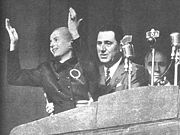
Eventually, she declined the invitation to run for vice-president, saying her only ambition was that in the large chapter of history that would be written about her husband, she hoped that in the footnotes there would be mention of a woman who brought the "hopes and dreams of the people to the president", who eventually turned those hopes and dreams into "glorious reality". In Peronist rhetoric, this event has come to be referred to as "The Renouncement", portraying Evita as having been a selfless woman in line with the Hispanic myth of marianismo. Most biographers, however, postulate that Evita did not so much renounce her ambition as bow out due to pressure from her husband, the military, and the Argentine upper class, who preferred that she not enter the race.
By 1951, it had also become evident that her health was rapidly deteriorating. In early 1950, Evita fainted in public and underwent surgery a few days later. Although it was reported that she had undergone an appendectomy, she had actually developed advanced cervical cancer. Fainting continued through 1951 (including the evening after "Cabildo abierto"), with extreme weakness and severe vaginal bleeding. Although her diagnosis was withheld from her by Juan, she knew she was not well, and a bid for the vice-presidency was not practical in light of her condition. Only a few months after "the Renouncement," Evita underwent a secret radical hysterectomy in an attempt to cure her of her advanced cervical cancer.
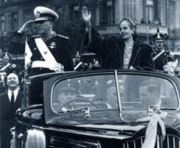
Re-election and Spiritual Leader of the Nation
On June 4, 1952, Evita rode with Juan Perón in parade through Buenos Aires in celebration of his re-election as President of Argentina. (This was the first election in which Argentine women had been allowed to vote. Evita had organized women voters into the first truly powerful female political party in the country's history.) Evita was by this point so ill that she was unable to stand without support. Underneath her oversized fur coat was a frame made of plaster and wire that allowed her to stand. She took a triple dose of pain medication before the parade, and took another two doses when she returned home.
In an official ceremony a few days after Juan Perón's second inauguration, Evita was given the official title of "Spiritual Leader of the Nation".
Death
Passing and funeral
Despite having undergone a hysterectomy by the eminent American surgeon George T. Pack, Evita's cancer returned rapidly. She developed lung metastasis and was the first Argentinian to undergo chemotherapy (a novel treatment at that time). Despite all available treatment, she became emaciated, weighing only 36 kg (about 79 lb.) by June 1952. Evita died at the age of 33, at 8:25 p.m. on July 26, 1952. The news was immediately broadcast throughout the country, and Argentina went into mourning: all activity in Argentina stopped: movies stopped playing, restaurants were closed and patrons were shown to the door. A radio broadcast interrupted the broadcasting schedule, with the announcer reading, "It is my sad duty to inform you that today at 8:25 p.m. Eva Perón, Spiritual Leader of the Nation, entered immortality". Eva Perón was granted an official state funeral. Evita's time of death was officially stated as 8:25 p.m.
Mourning
Upon Eva Perón's death, the government suspended all official activities for two days, with all flags being flown at half-mast for ten days. It soon became apparent, however, that these measures fell short of reflecting popular grief. The crowd outside of the official presidential residence had grown dense, congesting the streets for ten blocks in each direction. Later, while Evita's body was being moved, eight people were crushed to death in the throngs. In the following 24 hours, over 2000 people would be treated in city hospitals for injuries sustained in the rush to be near Evita as her body was being transported from the presidential residence to the Ministry of Labour building. The streets of Buenos Aires overflowed with flowers that were stacked in huge piles, and within one day of Evita's death, all flower shops in Buenos Aires had run out of flowers. Despite the fact that Eva Perón never held an official political office, she was eventually given an official funeral usually reserved for a head of state.
There were different interpretations of the popular mourning of Eva Perón's death. Some reporters viewed that the mourning was authentic, while others felt that the popular grief was merely the result of the public succumbing to the "passion plays" of the Peronist regime. For example, according to a Time magazine article published on August 11, 1952 entitled "In Mourning," the Peronist government enforced the beginning of daily periods of five minutes of mourning, following the daily radio announcement. This article also published the following list which it referred to as the "extravagant tributes" offered during the mourning period:
- "The Union of Workers and Employees of the Food Industry cabled a request to Pope Pius XII to canonize Evita.
- "Minister of Public Health Ramon Carrillo ordered a 220 lb (100 kg). candle, the height of Evita (5 ft. 5 in.), to be installed in the ministry and lighted for an hour on the 26th day of every month (the day Evita died). Carrillo thought the candle would last 100 years or more.
- "Schoolkids got prizes for poems and essays praising Evita. They were also told that she "got sick because she kissed the ill, the lepers, the consumptives."
- "Carlos Aloé, super-Peronista governor of Buenos Aires province, fired an employee who refused to wear a black tie. A Buenos Aires youth was arrested for laughing on a streetcar. "Attitudes like this are antisocial," said Aloé.
- "Eva's political cronies in high office, who stand to retain power if they can keep her memory alive, formed an "Association of Friends of Eva Perón" and asked, "What would Christ have been without his disciples?" Deprived thereafter of her tremendous popularity and imposing presence, the regime was increasingly forced to resort to repressive measures to compensate for the lost magnetism and popular support that Evita generated."
During Evita's time, children born illegitimately did not have the same legal rights as those born to married parents. Biographer Julie M. Taylor, professor of anthropology at Rice University, has said that Evita was well aware of the pain of being born illegitimate. Taylor speculates that Evita's awareness of this may have influenced Evita's decision to have the law changed so that illegimitate children would henceforth be referred to as "natural" children. Upon her death, the Argentine public was told that Evita was only 30. The discrepancy was meant to dovetail with Evita's earlier tampering with her birth certificate. After becoming the first lady in 1946, Evita had her birth records altered to read that she had been born to married parents, and placed her birth date three years forward, making herself younger.
Memorial plans
Shortly before Evita's death, Dr Pedro Ara was approached to embalm the body. Fraser and Navarro write that it is doubtful that Evita herself ever expressed a wish to be embalmed and suggest that it was most likely Juan Perón's decision. Dr Ara was a professor of anatomy who had studied in Vienna and maintained an academic career in Madrid. His work was occasionally referred to as "the art of death". His highly advanced embalming technique consisted of replacing the corpse's blood with glycerine, which preserved all organs including the brain and created a very lifelike appearance, giving the body the appearance of "artistically rendered sleep". Dr Ara was known in Buenos Aires society for his work. Among the people he had embalmed was Spanish composer Manuel de Falla. Dr Ara claims that his embalming of Evita's corpse began on the night of her death and that by the next morning "the body of Eva Peron was completely and infinitely incorruptible" and therefore suitable for display to the public.
In the book Perón and the Enigmas of Argentina, biographer Robert D. Crassweller claims that the Anglo Saxon nations of North America and Europe largely misunderstood Argentina's response to the death of Eva Perón as well as the ornate funeral she was granted. Crassweller attributes this misunderstanding to the unique cultural makeup of the Peróns and Argentina itself, claiming that the Peróns are of the Hispanic tradition and that their opposition was largely of Anglo-Saxon extraction.
Almost lost among the memories of Evita that have caught the imagination of the world there was another that has been little noted but whose importance is considerable: the legacy of incomprehension. Her brief and dazzling years were so successful because, in good part, she was so profoundly of the ethos. 'I have the body and the soul and the blood of the people.' But it was the ethos of the old, Hispanic- Creole tradition, born in the interior out of Lima and nurtured on the Pampas. Like Perón, she was wholly indigenous in origin and formation and spirit; like him, she was distrusted and misunderstood in the Argentina of the Liberal System and in the outside world that knew only that Argentina.
The same was true with regard to Evita's dramatised death during her last ten months, the dying in public that she sought as confirmation of her devotion. Such an attitude toward mortality is a variation of the old Hispanic preoccupation with death and with the dignity and splendour associated with it. It had by then faded away in most of the European Catholic societies and it is unknown in the Anglo-Saxon nations. Therefore, many saw her ordeal and the response of Perón and of the vast public as elements in an essentially political passion play, an attempt to milk some sympathy and benefit out of what should have been a private tragedy. It was simply the legacy of incomprehension, the same legacy that made it impossible for Evita and Perón to grasp fully the emotional intensity of much of the world reaction to the seizure of La Prensa, or other repressions of the Peronato. Thus Evita lived and died, an object of wonder to the world and a memorial to the inability of one ethos truly to understand another.
Disappearance and return of corpse
Shortly after her death, plans were made to construct a monument in Evita's honour. The monument, which was to be a statue of a man representing the "descamisados", was projected to be larger than the Statue of Liberty. Evita's body was to be stored in the base of the monument and, in the tradition of Lenin's corpse, to be displayed for the public. While waiting for the monument to be constructed, Evita's embalmed body was displayed in her former office at the CGT building for almost two years. Before the monument to Evita was completed, Juan Perón was overthrown in a military coup, the Revolución Libertadora, in 1955. Perón hastily fled the country and did not make arrangements to secure Evita's body.
A military dictatorship took power in Argentina. The new authorities removed Evita's body from display and its whereabouts remained a mystery for 16 years. From 1955 until 1971, the military dictatorship of Argentina issued a ban on Peronism. It became illegal not only to possess pictures of Juan and Eva Perón even in one's home, but to even speak their names. After sixteen years, the military finally revealed the location of Evita's body. It had been buried in a crypt in Milan, Italy under the name "María Maggi". In 1995, Tomás Eloy Martínez published "Santa Evita", which detailed many previously unknown facts about the escapades of Evita's corpse, such as the fact that many wax copies of the corpse were made. Martínez claimed that the corpse was damaged with a hammer and that one officer even committed sexual acts on one of the copies of the corpse.
Final resting place
In 1971, Evita's body was exhumed and flown to Spain, where Juan Perón maintained the corpse in his home. In 1973, Juan Perón came out of exile and returned to Argentina, where he became president for the third time. Perón died in office in 1974. Isabel Perón, who had been elected vice-president, succeeded him, thus became the first female president in the world. It was Isabel who had Evita's body returned to Argentina and (briefly) displayed beside Juan Perón's. The body was later buried in the Duarte family tomb in La Recoleta Cemetery, Buenos Aires. Extensive measures were taken by the Argentinian government to secure Evita's tomb. There is a trapdoor in the tomb's marble floor, which leads to a compartment that contains two coffins. Under the first compartment is a second trapdoor and a second compartment. That is where Evita's coffin rests. Biographers Marysa Navarro and Nicholas Fraser write that the claim is often made that Evita's tomb is so secure that it could withstand a nuclear attack. "It reflects a fear," they write, "a fear that the body will disappear from the tomb and that the woman, or rather the myth of the woman, will reappear."
Legacy and criticism
Argentina and Latin America
Though it is not an official government holiday, the anniversary of Eva Perón's death is marked by Argentines every year. Additionally, Eva Perón has been featured on Argentine coins, and a form of Argentine currency called "Evitas" was named in her honour. Ciudad Evita (Evita City), which was established by the Eva Perón Foundation in 1947, is located just outside of Buenos Aires. It remains a thriving community to this day. Cristina Kirchner, the first elected female president in Argentine history, is a Peronist who has occasionally been referred to as "The New Evita." Kirchner says she does not want to compare herself to Evita, claiming Evita was a unique phenomenon in Argentine history. However, Kirchner says that women of her generation who came of age in the 1970s during the military dictatorships in Argentina owe a debt to Evita for offering an example of passion and combativeness.
On July 26, 2002, the 50th anniversary of Eva Perón's death, a museum opened in her honour called "Museo Evita". The museum, which was created by her great-niece Cristina Alvarez Rodriquez, houses many of Eva Perón's clothes, portraits, and artistic renderings of her life. It has become a popular tourist attraction. The museum was opened in a building that was once used by the Eva Perón Foundation.
Biographers Fraser and Navarro claim that because Eva Perón died at the peak of her popularity, her myth has remained intact and she remains one of the most important symbols of Peronism. Fraser writes of his 1980 visit to Argentina:
"I discovered that her myth burnt most brightly among poor people, who could be seen placing flowers each Sunday on her tomb in Recoleta; but she was also capable of instilling fear among those who had conspired to remove her embalmed body after her death, hiding it for twenty-odd years. Such people — generals or admirals, men habituated to obedience — remembered that a Prime Minister of Argentina had been kidnapped only five years before, tried for his role in the disappearance of Evita's body, and summarily executed. Sitting in darkened apartments beneath photographs of themselves as moustached cadets, bodyguards standing at the door, they were nervous when they discussed their own relationship to 'that woman', afraid that she would somehow come back to take revenge on them."
In the book Eva Perón: The Myths of a Woman, cultural anthropologist Julie M. Taylor claims that Evita has remained important in Argentina due to the combination of three unique factors:
"In the images examined, the three elements consistently linked — femininity, mystical or spirituality power, and revolutionary leadership — display an underlying common theme. Identification with any one of these elements puts a person or a group at the margins of established society and at the limits of institutional authority. Anyone who can identify with all three images lays an overwhelming and echoing claim to dominance through forces that recognize no control in society or its rules. Only a woman can embody all three elements of this power."
Taylor argues that the fourth factor in Evita's continued importance in Argentina relates to her status as a dead woman and the power that death holds over the public imagination. Further, Taylor claims that Evita's embalmed corpse is analogous to the incorruptibility of various Catholic saints, such as Bernadette Soubirous, and therefore holds powerful symbolism within the largely Catholic cultures of Latin America.
"To some extent her continuing importance and popularity may be attributed not only to her power as a woman but also to the power of the dead. However a society’s vision of the afterlife may be structured, death by its nature remains a mystery, and, until society formally allays the commotion it causes, a source of disturbance and disorder. Women and the dead — death and womanhood — stand in similar relation to structured social forms: outside public institutions, unlimited by official rules, and beyond formal categories. As a female corpse reiterating the symbolic themes of both woman and martyr, Eva Perón perhaps lays double claim to spiritual leadership."
In a 1996 interview, Tomás Eloy Martínez referred to Eva Perón as "the Cinderella of the tango and the Sleeping Beauty of Latin America". Martínez suggested Eva Perón has remained an important cultural icon for the same reasons as fellow Argentine Che Guevara:
"Latin American myths are more resistant than they seem to be. Not even the mass exodus of the Cuban raft people or the rapid decomposition and isolation of Fidel Castro's regime have eroded the triumphal myth of Ché Guevara, which remains alive in the dreams of thousands of young people in Latin America, Africa and Europe. Ché as well as Evita symbolize certain naive, but effective, beliefs: the hope for a better world; a life sacrificed on the altar of the disinherited, the humiliated, the poor of the earth. They are myths which somehow reproduce the image of Christ."
In his essay titled "Latin America" published in The Oxford Illustrated History of Christianity, John McManners also claims that the appeal and success of Eva Perón can be related in terms of Latin American mythology and concepts of divinity. McManners even claims that Eva Perón consciously incorporated these themes into her public persona.
“Drawing on the mythology of the Virgin, and of Mary Magdalene, to picture herself as a larger-than-life, succoring mother to the poor, ‘Evita’ demonstrated her purported sanctity through social work, in the tradition of a long line of notable colonial beatas whose passion for charity had helped earn them sainthood. Evita became the most successful of ‘supermadre’ types into which several ambitious Latin American politicians tried to convert their wives, or daughters.”
Allegations of fascism
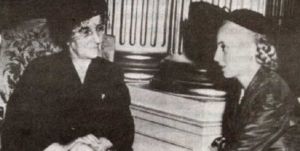
Fraser and Navarro write that Juan Perón's opponents had from the start accused Perón of being a fascist. Fraser and Navarro also theorize that the perception of the Peróns as fascists was enhanced during Evita's 1947 European tour during which Evita was a guest of honour of Francisco Franco. By 1947, Franco had become politically isolated as one of the few remaining fascists to retain power. Franco, therefore, was in desperate need of a political ally. As much as a third of Argentina's population is of Spanish descent, and therefore it seemed natural that Argentina would have diplomatic relations with Spain. Commenting on the international perception of Evita during her 1947 European tour, Fraser and Navarro write, "It was inevitable that Evita be viewed in a fascist context. Therefore, both Evita and Perón were seen to represent an ideology which had run its course in Europe, only to re-emerge (sic) in an exotic, theatrical, even farcical form in a faraway country."
Laurence Levine, the former president of the U.S.-Argentine Chamber of Commerce, writes that in contrast to Nazi ideology, the Peróns were not anti-Semitic. In the book Inside Argentina from Perón to Menem: 1950–2000 from an American Point of View, Lawrence Levine writes:
The American government demonstrated no knowledge of Perón's deep admiration for Italy (and his distaste for Germany, whose culture he found too rigid). Nor did they appreciate that although anti-Semitism existed in Argentina, Perón's own views and his political associations were not anti-Semitic. They paid no attention to the fact that Perón sought out the Jewish community in Argentina to assist in developing his policies and that one of his most important allies in organizing the industrial sector was José Ber Gelbard, a Jewish immigrant from Poland.
Historian Robert D. Crassweller, author of Perón and the Enigmas of Argentina, does not address the allegations of Eva Perón's involvement with Nazi war criminals. However, Crassweller does address the allegation of Peronism's ties with Nazi and fascist political ideology. Crassweller writes, "Peronism was not fascism", and "Peronism was not Nazism." Crassweller also refers to the comments of U.S. Ambassador George S. Messersmith. While visiting Argentina in 1947, Messersmith made the following statement: "There is not as much social discrimination against Jews here as there is right in New York or in most places at home..."
In his review of the 1996 movie Evita, movie critic Roger Ebert criticized Eva Perón, writing, "She let down the poor, shirtless ones by providing a glamorous facade for a fascist dictatorship, by salting away charity funds, and by distracting from her husband's tacit protection of Nazi war criminals." Time Magazine later published an article by Tomás Eloy Martínez, Director of the Latin American program at Rutgers University, titled "The Woman Behind the Fantasy: Prostitute, Fascist, Profligate — Eva Perón was Much Maligned, Mostly Unfairly". In this article, Martínez writes that the accusations that Eva Perón was a fascist, nazi, and a thief, the accusations Ebert makes against Eva Perón, have been leveled against Evita for decades. Martínez writes that these accusations are actually untrue:
She was not a fascist—ignorant, perhaps, of what that ideology meant. And she was not greedy. Though she liked jewelry, furs and Dior dresses, she could own as many as she desired without the need to rob others.... In 1964 Jorge Luis Borges stated that "the mother of that woman [Evita]" was "the madam of a whorehouse in Junin." He repeated the calumny so often that some still believe it or, more commonly, think Evita herself, whose lack of sex appeal is mentioned by all who knew her, apprenticed in that imaginary brothel. Around 1955 the pamphleteer Silvano Satander employed the same strategy to concoct letters in which Evita figures as an accomplice of the Nazis. It is true that Peron facilitated the entrance of Nazi criminals to Argentina in 1947 and 1948, thereby hoping to acquire advanced technology developed by the Germans during the war. But Evita played no part. She was far from being a saint, despite the veneration of millions of Argentines, but she was not a villain either. Human beings are full of contradictions and labyrinthine complexities. Rarely do they resemble their portrayal in the musicals of Hollywood and Broadway.
In his doctoral dissertation for Ohio State University, Lawrence D. Bell writes that Juan Perón's government was not anti-semitic, but that the governments that preceded Juan Perón had been. The governments that preceded Juan Perón had seen it as ideal to exclude the Jewish community as much as possible from government affairs. According to Bell, Juan Perón attempted to reverse this trend, attempting to recruit the Jewish community into his government and even setting up an entire branch of the Peronist government for Jewish members:
The rise of Perón profoundly challenged this ideal. Both as a means of attracting internal support for his ‘New Argentina,’ as well as to dispel his image as a Nazi-style fascist within the international community, Perón eagerly and enthusiastically sought to recruit the participation of the Jewish community as a community, and not merely as Jewish individuals, to the cause of the Peronist movement. In the words of Isaias Lerner, the son of a prominent communal leader during the Peronist era, “The triumph of Perón ... meant a greater participation of the community in the political arena. For the first time in Argentina’s political history, a political party courted our community."
International popular culture
By the late 20th century, Eva Perón had become the subject of numerous articles, books, stage plays, and musicals, ranging from the biography The Woman with the Whip to the B-grade film Little Mother, and a 1981 TV movie called "Evita Peron" with Faye Dunaway in the title role. The most successful rendering of Eva Perón's life has been the musical production Evita. The musical began as a concept album co-produced by Tim Rice and Andrew Lloyd Webber, with Julie Covington in the title role. Elaine Paige would later be cast in the title role when the concept album was adapted into a musical stage production in London's West End. In 1980, Patti LuPone won the Tony Award for Best Leading Actress in a Musical for her performance as the title character. Nicholas Fraser claims that to date the musical stage production has been performed on every continent except Antarctica and has generated over $2 billion in revenue.
As early as 1978, the musical was considered as the basis for a movie, with everyone from Patti LuPone to Liza Minnelli to Michelle Pfeiffer to Meryl Streep being considered for the title role. After a nearly 20-year production delay, Madonna was cast in the title role for the film version and won the Golden Globe Award for "Best Actress in a Musical or Comedy".
In response to the American film, and in an alleged attempt to offer a more politically accurate depiction of Evita's life, an Argentine film company released Eva Perón: The True Story. The Argentine production starred actress Esther Goris in the title role. This movie was the 1996 Argentine submission for the Oscar in the category of "Best Foreign Film".
In 2003, the American cartoon The Simpsons parodied the musical in an episode called " The President Wore Pearls". In this episode, Lisa Simpson seeks to be the president of the Springfield Elementary student body. The episode contains five songs, all of which are parodies of songs from Evita. For example, one song Lisa Simpson sings is called Don't Cry for Me, Kids of Springfield, which is a parody of Evita's most famous song Don't Cry for Me, Argentina. The episode ends with the following disclaimer: "On the advice of our lawyers, the producers would like to stress that they have never heard of a musical based on the life of Eva Perón."
Nicholas Fraser writes that Evita is the perfect popular culture icon for our times because her career foreshadowed what, by the late 20th century, had become common. During Evita's time it was considered scandalous for a former entertainer to take part in public political life. Her detractors in Argentina had often accused Evita of turning public political life into show business. But by the late 20th century, Fraser claims, the public had become engrossed in the cult of celebrity and public political life had become insignificant. Former actors and entertainers, from Ronald Reagan to Sonny Bono, Arnold Schwarzenegger, and Glenda Jackson, have often taken public political offices. In this regard, Evita was perhaps ahead of her time. Fraser also writes that Evita's story is appealing to our celebrity-obsessed age because her story confirms one of Hollywood's oldest clichés, the rags to riches story.
In the epilogue for the 1996 reissue of Evita: The Real Life of Eva Perón Nicholas Fraser commented on Evita's late 20th century reemergence as a figure in popular culture:
"'I will come again, and I will be millions,' Evita had said in one of her apocalyptic last speeches just before her death; but even she could not have foreseen her sudden transformation, from Latin American politician and religiose [sic] national cult figure to late-twentieth-century popular culture folk heroine.... In her own country her story is at last part of history, arousing the sort of peaceful controversy one might expect from so astonishing a career. In the rest of the world, however, she has attained the condition of apotheosis — becoming a deity in the new world pantheon of electric celebrity."
